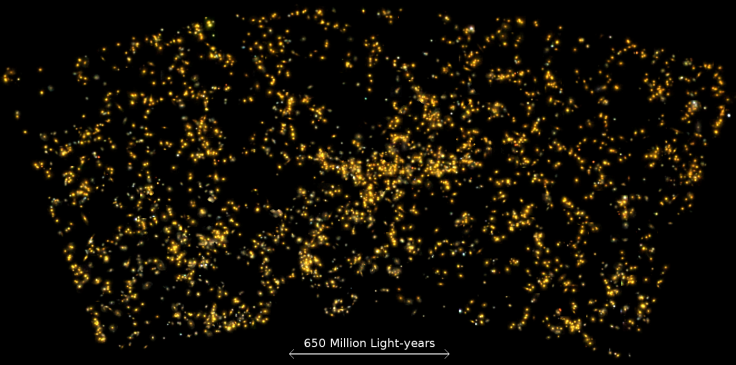Astronomers Discover A Supercluster Of Galaxies

A team of astronomers from India has identified a supercluster of galaxies that has the capacity of containing thousands of suns, billions of stars, planets, dark matter and other bodies. Researchers from the Inter University Centre for Astronomy & Astrophysics (IUCAA), Indian Institute of Science Education and Research (IISER) and members of two other Indian universities have called this supercluster “one of the largest known structures in the nearby areas of the universe."
The supercluster "Saraswati" has been named after a Hindu godesss and a major river, around which the people of the ancient Indian civilization lived in the past. It is believed to be four billion light-years away from Earth. Nearly 10 billion years old, Saraswati is estimated to be stretched over 650 million light years in distance, and is located in the direction of the constellation Pieces.
A supercluster, as the name suggests, is a chain of galaxies and galaxy clusters bound by gravity. The largest of them could spread over several million light years of space. Ninety percent of the galaxies are thought to be located in them.
Read: Hubble Finds Massive Galaxies Aligned With Their Surroundings 10 Billion Years Ago
According to the astronomers, who discovered Saraswati, most forms of the popular model explaining the evolution — the Cold dark MatterModel — do not predict the existence of such superclusters in the current age of the universe. As per the model, smaller structures like galaxies are formed first, which congregate to form large structures.
However, the discovery of these extremely large structures is forcing the astronomers to re-think the popular theories of how the Universe got its current form, starting from a more-or-less uniform distribution of energy after the Big Bang , according to the IUCAA. Researchers have been referring to the Dark Energy hypothesis since 1990s to indicate the expansion of the universe at an accelerating rate. The hypothesis has also been considered an explanation for the formation of these superclusters.
The astronomers, who headed the research, expect the discovery would help in understanding the galaxy evolution and the effect of superclusters on the environment of galaxies better. The findings will be published in The Astrophysical Journal on July 19.
Talking about the discovery, Joydeep Bagchi from the IUCAA, the lead author of the paper, and co-author Shishir Sankhyayan, a PhD scholar at IISER, said in a statement: ‘’We were very surprised to spot this giant wall-like supercluster of galaxies, visible in a large spectroscopic survey of distant galaxies, known as the Sloan Digital Sky Survey. This supercluster is clearly embedded in a large network of cosmic filaments traced by clusters and large voids.”
Galaxies are gravitationally bound and are a part of filaments —massive thread-like formations— that form the boundaries between large cosmic voids in the universe. When these galaxies travel along these filaments , they end up becoming dense clusters which halt their star formation and aid in the transformation of galaxies to disky blue spiral galaxies to red elliptical galaxies. As per the researchers, the environment within a supercluster is extremely varied and galaxies travel through these varied environments during their lifetime.
Read: Hyperactive Star-Producing Galaxy Discovered, Could Explain Massive Galaxies In Early Universe
Milky Way, our own galaxy, is part of the Laniakea Supercluster, astronomer Brent Tully at the University of Hawaii and collaborators announced in 2014. The other known superclusters include Virgo Supercluster and Perseus-Pisces Supercluster.
© Copyright IBTimes 2024. All rights reserved.





















